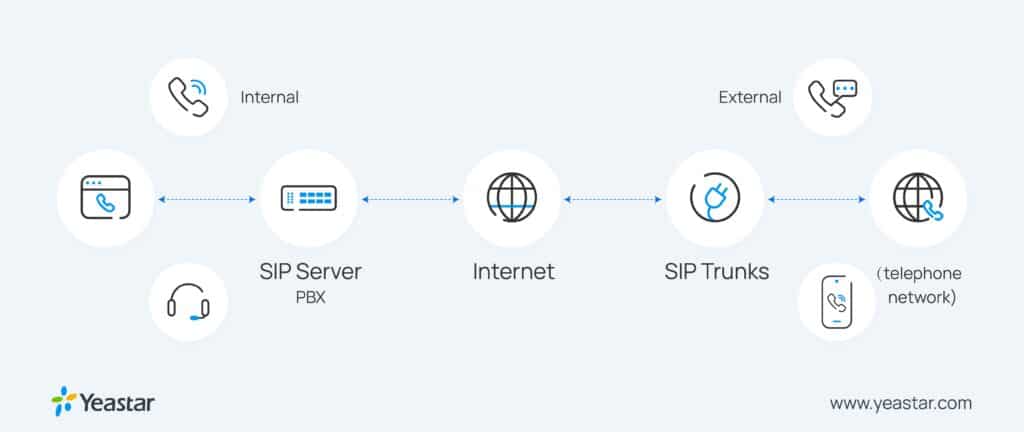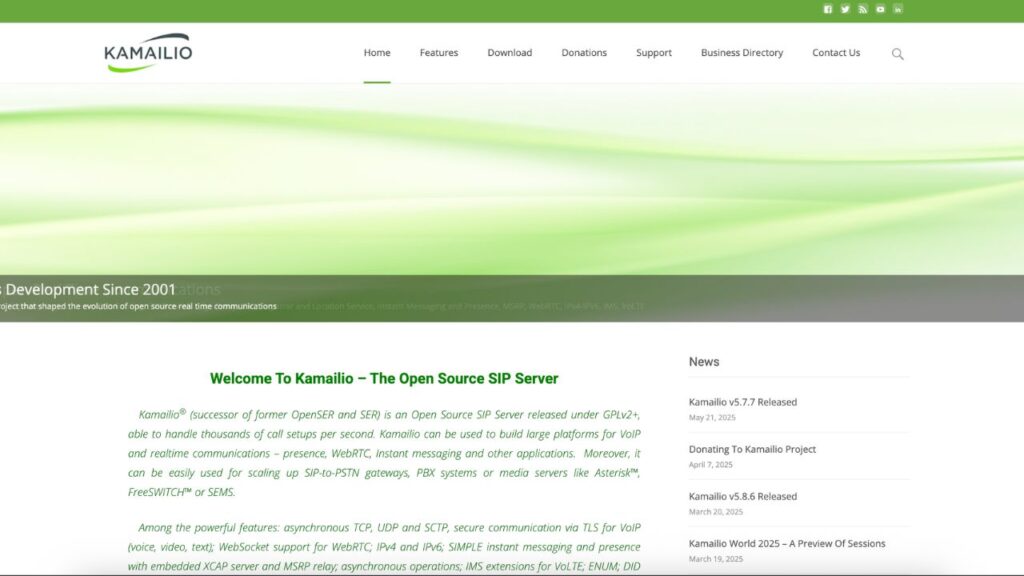You’re sitting at your desk, dreaming of slashing your business phone bill to zero while still making crystal-clear calls to clients across the globe. Or maybe you’re a tech enthusiast itching to set up a home VoIP system to impress your friends with free video chats.
Either way, you’ve heard whispers about SIP servers—the secret sauce behind Voice over Internet Protocol (VoIP) calls—and you’re thinking, Can I really get a free SIP server in 2025 that’s powerful enough for my needs?
Spoiler alert: Yes, you can, and it’s easier than you think! Imagine transforming your internet connection into a full-blown phone system without spending a dime, all while sipping coffee in your pajamas.
If you’re a small business owner, developer, or VoIP newbie looking to dive into internet telephony, this guide to the best free SIP servers is your golden ticket.
We’re spilling the beans on OpenSIPS, Kamailio, Asterisk, FreeSWITCH, and SIPp, with everything you need to know about their features, setups, and real-world uses.
We’ll walk you through why these open-source gems are perfect for VoIP calls, video conferencing, and more. Plus, we’ll toss in tips, a comparison table, and much more to make your SIP journey smooth as butter.
Want to supercharge your tech stack? Check out our guide on best free VoIP servers?
Ready to talk? Let’s dive into the world of free SIP servers!
- What is a SIP Server?
- Why Use Free SIP Servers?
- 5 Best Free SIP Servers in 2025
- 1. OpenSIPS – High-performance SIP server for scalability and control
- 2. Kamailio – Ultra-fast SIP router for demanding VoIP environments
- 3. Asterisk – The original open-source PBX – flexible, reliable, and powerful
- 4. FreeSWITCH – Modular VoIP platform for voice, video, and messaging
- 5. SIPp – Performance testing tool built for SIP stress testing and benchmarking
- Comparison Table: 5 Best Free SIP Servers in 2025
- Benefits of Free SIP Servers
- How to Choose the Right Free SIP Server?
- FAQs
- Conclusion
What is a SIP Server?
Essentially, a SIP server is the brain behind VoIP and internet calls. It handles all the tricky stuff for connecting and managing calls, video chats, and messages. Think of it as a super smart digital operator, routing everything online instead of through old-school phone lines.
This shift makes things way cheaper and more flexible. The SIP protocol, basically the rules of the game, helps the server set up and manage these conversations, dealing with everything from who’s invited to what kind of media is used.

The server also makes sure everyone is who they say they are and offers handy features like forwarding and voicemail. All this together helps companies build a single system for all their communication needs, saving money and making it easier for people to work from anywhere.
Basically, SIP servers are a game-changer, making communication better and cheaper than traditional phones.
How It Works:
- Initiation: A SIP client (e.g., a softphone like Jitsi) sends an INVITE message to start a call.
- Management: The server routes requests, handles responses (e.g., 200 OK), and maintains the session.
- Termination: A BYE message ends the call, freeing up resources.
Key Functions:
- Manages SIP signaling for call setup, modification, and teardown.
- Supports multimedia sessions (voice, video, messaging).
- Integrates with protocols like RTP (Real-Time Transport Protocol) and SDP (Session Description Protocol) for media delivery.
- Enables features like call forwarding, conferencing, and presence.
Why Go Free? Open-source SIP servers like Kamailio or Asterisk offer enterprise-grade features without the hefty price tag, perfect for startups, developers, or hobbyists.
Why Use Free SIP Servers?
With VoIP adoption soaring (projected to grow 10% annually, per ibm. com), free SIP servers are a no-brainer for cost-conscious users. Here’s why they rock:
- Zero Cost: Save thousands compared to paid solutions like 3CX or Vonage.
- Customizability: Tweak open-source code for your needs (e.g., custom call routing).
- Scalability: Handle thousands of calls, from home setups to enterprise platforms.
- Community Support: Active forums and GitHub repos (e.g., OpenSIPS) offer free help.
- Security: Regular updates and TLS encryption keep your calls safe.
- Future-Proof: Support modern features like WebRTC for browser-based calls.
5 Best Free SIP Servers in 2025
Here are the top five free, open-source SIP servers for 2025, chosen for their features, reliability, and community support.
- OpenSIPS – High-performance SIP server for scalability and control.
- Kamailio – Ultra-fast SIP router for demanding VoIP environments.
- Asterisk – The original open-source PBX – flexible, reliable, and powerful.
- FreeSWITCH – Modular VoIP platform for voice, video, and messaging.
- SIPp – Performance testing tool built for SIP stress testing and benchmarking.
1. OpenSIPS – High-performance SIP server for scalability and control

OpenSIPS stands as a robust and highly efficient SIP proxy/server, meticulously engineered to provide exceptional routing and load balancing capabilities essential for the deployment and management of extensive Voice over Internet Protocol (VoIP) infrastructures.
This sophisticated technology has garnered significant popularity among telecommunications providers and Internet Telephony Service Providers (ITSPs) due to its proven reliability and performance.
OpenSIPS is designed with versatility at its core, offering comprehensive support for a diverse array of real-time communication services, encompassing not only traditional voice calls but also video conferencing, instant messaging, and presence information management..
Its lightweight nature ensures minimal resource utilization, while its high-performance architecture guarantees optimal throughput and minimal latency, crucial for handling large volumes of SIP traffic in demanding network environments.
Key Features:
- Scalability: Handles 10,000+ concurrent calls on modest hardware.
- Modules: 90+ extensions for routing, accounting, and NAT traversal.
- Flexibility: Supports Class 4/5 platforms, PBX, and wholesale.
- Security: TLS, digest authentication, and IP whitelisting.
- OS Support: Linux (Ubuntu, Debian, CentOS).
Pros:
- Fast and reliable for high-traffic setups.
- Active community with LTS support.
- Easy integration with WebRTC and Kamailio.
Cons:
- Steep learning curve for beginners.
- Limited GUI (use Siremis for web management).
2. Kamailio – Ultra-fast SIP router for demanding VoIP environments

Kamailio, originally known as OpenSER, stands as a highly resilient and exceptionally scalable Session Initiation Protocol (SIP) server, designed to facilitate real-time communication. Renowned for its strong emphasis on security and its unparalleled flexibility, Kamailio is an optimal choice for a diverse range of applications.
It proves particularly well-suited for large telecommunication carriers requiring robust infrastructure and for enterprise-level Private Branch Exchange (PBX) systems seeking advanced call control and routing capabilities.
The platform’s architecture enables it to handle a substantial volume of concurrent SIP sessions, making it a critical component for high-traffic communication networks.
Kamailio’s open-source nature also fosters a community-driven development model, leading to continuous improvements and adaptations to evolving communication technologies and security threats.
Key Features:
- High Throughput: Supports 25,000+ calls per second.
- Security: TLS, SRTP, and anti-fraud modules.
- Modules: Over 100 for load balancing, presence, and IMS.
- Web Management: Use Siremis or custom scripts, per sourceforge.net.
- OS Support: Linux, FreeBSD, Solaris.
Pros:
- Rock-solid for large-scale deployments.
- Extensive documentation and GitHub support.
- Integrates with Asterisk for hybrid setups.
Cons:
- Complex configuration for newbies.
- No native Windows support.
3. Asterisk – The original open-source PBX – flexible, reliable, and powerful

Asterisk, recognized as the world’s most widely adopted open-source Private Branch Exchange (PBX) and Session Initiation Protocol (SIP) server, stands at the forefront of Voice over Internet Protocol (VoIP) technology. This powerful platform empowers millions of VoIP systems globally, underpinning their operations with its comprehensive and sophisticated feature set.
Offering unparalleled flexibility and customization, Asterisk enables businesses and individuals to create robust and tailored communication solutions, ranging from simple call routing to complex unified communications platforms.
Its open-source nature fosters a vibrant community of developers and users who continually enhance and support the software, ensuring its ongoing evolution and relevance in the dynamic telecommunications landscape.
Key Features:
- PBX Features: Voicemail, IVR, call forwarding, conferencing.
- Codecs: Supports G.711, G.729, Opus for high-quality audio.
- WebRTC: Browser-based calls with modern browsers.
- GUI: FreePBX for easy management.
- OS Support: Linux, macOS, Windows (via WSL).
Pros:
- Beginner-friendly with FreePBX GUI.
- Massive community and tutorials.
- Flexible for small to large setups.
Cons:
- Resource-heavy for high call volumes.
- Security requires manual hardening.
4. FreeSWITCH – Modular VoIP platform for voice, video, and messaging

FreeSWITCH stands out as a highly adaptable and robust SIP server and softswitch, designed to handle a wide range of communication needs including voice, video, and messaging services. Its versatility is rooted in its powerful architecture, which enables it to function seamlessly across multiple operating systems, ensuring broad compatibility and flexibility in deployment.
This cross-platform capability makes FreeSWITCH a preferred choice for developers and businesses looking to implement unified communications solutions. Moreover, its modern design facilitates scalability and efficient performance, catering to environments from small businesses to large enterprises.
The architecture’s modularity allows for extensive customization and the integration of diverse features, empowering users to tailor the system to specific requirements and evolving communication trends.
Key Features:
- Multimedia: Handles voice, video, SMS, and WebRTC.
- Scalability: Supports 1,000+ concurrent calls.
- APIs: Lua, Python, and JavaScript for custom apps.
- Security: TLS, SRTP, and ZRTP encryption.
- OS Support: Linux, Windows, macOS.
Pros:
- Modern, modular design.
- Strong WebRTC support.
- Active Slack and GitHub community.
Cons:
- Complex XML-based configuration.
- Smaller community than Asterisk.
5. SIPp – Performance testing tool built for SIP stress testing and benchmarking

SIPp, standing for SIP Performance, is a robust and freely available, open-source application designed for rigorous testing of Session Initiation Protocol (SIP). It functions both as a sophisticated traffic generator and a lean server, meticulously engineered to produce and scrutinize SIP signaling.
This makes SIPp an invaluable asset for developers and system administrators tasked with ensuring the stability, performance, and reliability of SIP-based communication systems.
It enables comprehensive simulation of various SIP scenarios, from basic call flows to complex, multi-party conferences, allowing for thorough evaluation under varying load conditions and network configurations.
Key Features:
- Traffic Generation: Simulates thousands of SIP calls for stress testing.
- Scenarios: Custom XML files for complex call flows.
- Statistics: Real-time call rate and delay metrics.
- Protocols: Supports TCP, UDP, TLS, IPv6.
- OS Support: Linux, Windows, macOS.
Pros:
- Perfect for testing SIP setups.
- Lightweight and easy to install.
- Open-source with GitHub support.
Cons:
- Not a full SIP server (testing-focused).
- Limited for production use.
Comparison Table: 5 Best Free SIP Servers in 2025
| SIP Server | Best For | Key Features | OS Support | Ease of Use |
|---|---|---|---|---|
| OpenSIPS | Large-scale VoIP, telecoms | Proxy, routing, 90+ modules | Linux | Moderate |
| Kamailio | Enterprise, carriers | Scalability, security, 100+ modules | Linux, FreeBSD | Hard |
| Asterisk | PBX, small businesses | FreePBX, IVR, conferencing | Linux, Windows, macOS | Easy |
| FreeSWITCH | Multimedia, WebRTC | Voice, video, APIs, modern design | Linux, Windows, macOS | Moderate |
| SIPp | Testing, development | Traffic generation, stress testing | Linux, Windows, macOS | Easy |
Benefits of Free SIP Servers
Free SIP servers pack a punch for VoIP users:
- Cost Savings: Eliminate $100–$1,000/month PBX or SIP trunking fees.
- Flexibility: Customize features like IVR or call analytics.
- Scalability: Scale from 10 to 10,000 users with Kamailio or OpenSIPS.
- Global Reach: Make free SIP-to-SIP calls worldwide via Jitsi or Linphone.
- Security: Use TLS and SRTP for encrypted calls.
- Integration: Pair with Cloudflare for DDoS protection or NordVPN for secure access.
How to Choose the Right Free SIP Server?
Picking the perfect SIP server depends on your needs:
- Small Business or Home Use: Asterisk with FreePBX for easy PBX features.
- Large-Scale Telecom: OpenSIPS or Kamailio for high throughput.
- Multimedia Apps: FreeSWITCH for WebRTC and video.
- Testing/Development: SIPp for stress testing.
- Budget: All are free, but factor in VPS costs ($5–$20/mo).
- Ease of Use: Asterisk is beginner-friendly; Kamailio needs expertise.
FAQs
Q1: What is a SIP server?
Ans: A SIP server manages VoIP calls by handling signaling for call setup, management, and termination, per 3cx. com.
Q: Are free SIP servers reliable?
A: Yes, open-source servers like Asterisk and Kamailio power enterprise-grade VoIP with proper setup.
Q: Can I use free SIP servers for business?
A: Absolutely! OpenSIPS or Asterisk support call centers, PBX, and more, saving thousands.
Q: What’s the easiest free SIP server to set up?
A: Asterisk with FreePBX is beginner-friendly with a GUI
Q: Do free SIP servers support video calls?
A: Yes, FreeSWITCH and Asterisk handle video via WebRTC
Conclusion
That’s the ultimate rundown on the 5 best free SIP servers in 2025! Whether you’re building a call center with OpenSIPS, running a home PBX with Asterisk, or testing VoIP with SIPp, these open-source powerhouses let you harness VoIP without breaking the bank.
From Kamailio’s enterprise-grade scalability to FreeSWITCH’s multimedia magic, there’s a free SIP server for every need. Pair them with a VPS like DigitalOcean or Hetzner, secure with Cloudflare, and you’re ready to make free, crystal-clear calls worldwide.
Give Asterisk a spin for an easy start, or dive into Kamailio for pro-level VoIP. Want to boost your tech game further? Explore our guide on What is a GPU Server? Got a favorite SIP server or VoIP tip? Drop it in the comments—I’m all ears! For more tech insights, check out our posts on Difference Between Web Server and Web Client (#) or Types of Virtualization in Cloud Computing (#).
Here’s to free calls and unstoppable VoIP in 2025!




